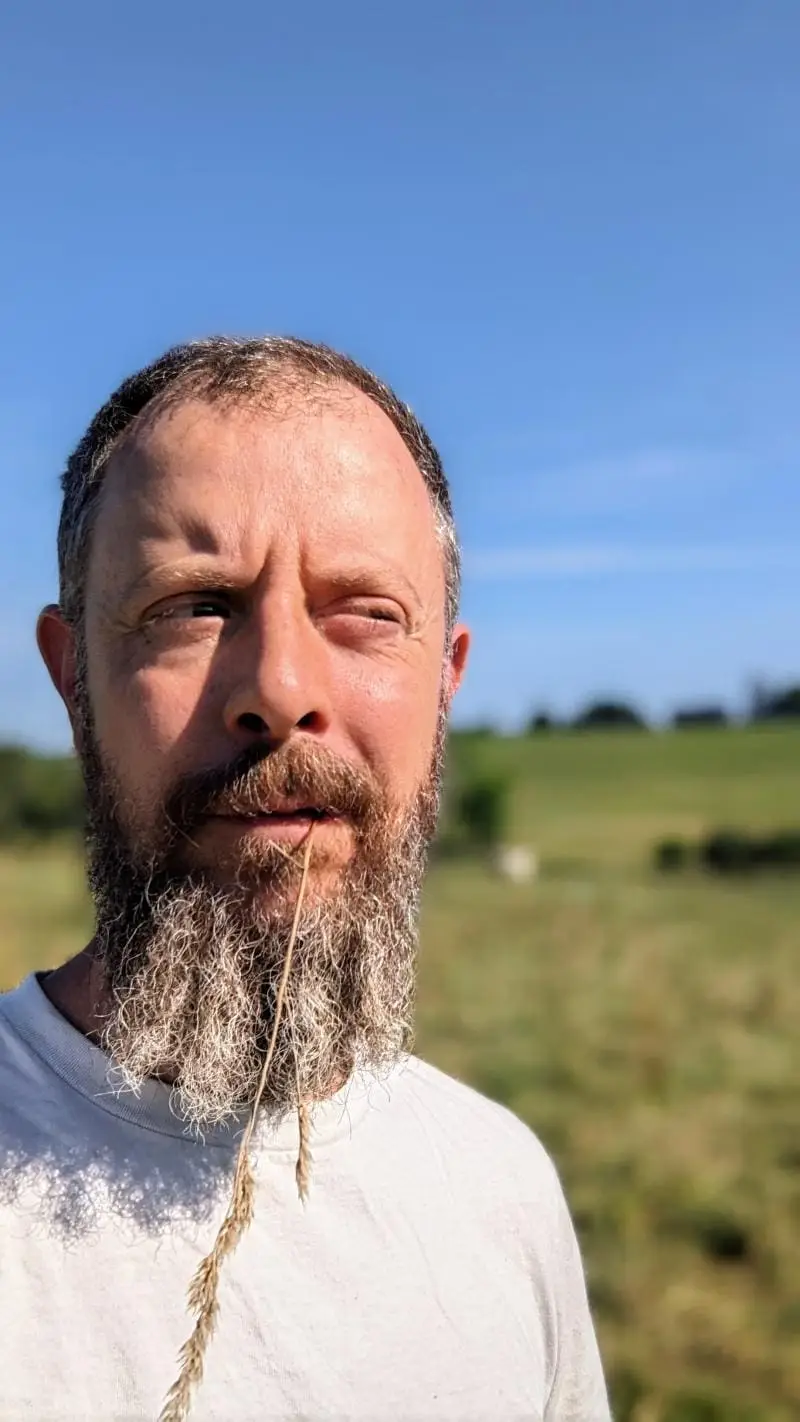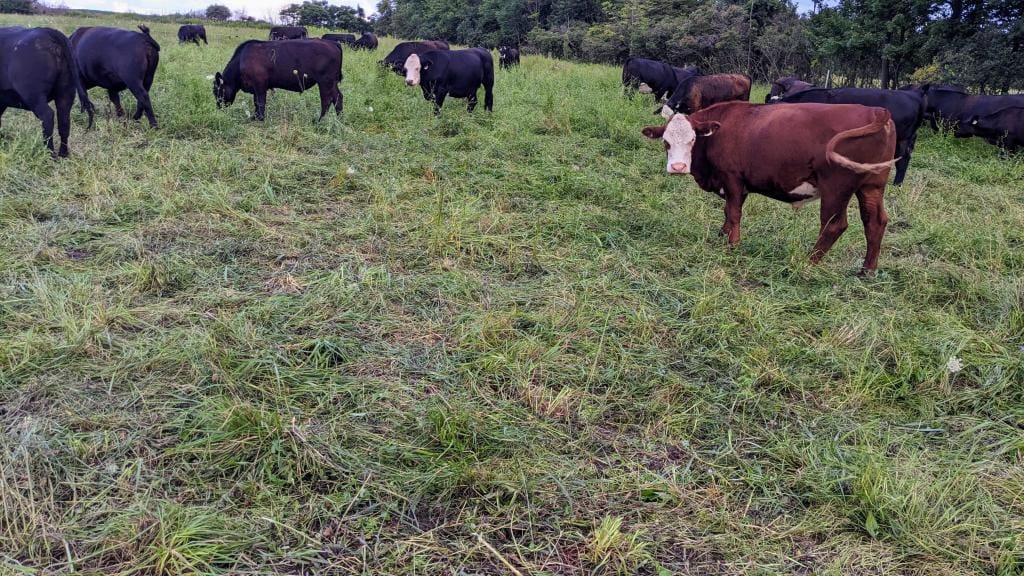There’s an oft-used visual representation of farmers depicting them chewing on a stem of grass. The wardrobe managers for films and photoshoots depend on old tropes, probably under the assumption that the audience is too dense to recognize the hayseed farmer character without a well-gnawed stalk planted firmly in the middle of a wrinkled face. But have you ever wondered what’s behind this depiction, why humans would be munching grass?
One simple answer is that old farmers didn’t have access to machine made toothpicks and flossers, but they did have grass. We’ve probably all noticed that mature grass is pretty tough. So grass stalks could function as toothpicks and gum stimulators. But my experience leads me to believe this pattern of grass eating might be about more than just oral hygiene.

It occurred to me a few days ago that wherever I go on the farm, I’m always feeling, smelling, and especially tasting. And more than grasses, as I go through the fields I’m chewing leaves, stalks, bark, and flowers. I’m rubbing plants between my fingers to feel the moisture content and to release the odors. Without intentionally setting out to adopt these behaviors, I’ve gradually picked up the habits of using a more complete assortment of senses to understand the state of the farm.
I’m confident that my cattle know much more about each pasture than I ever might know. But I’m pleased to realize that there’s so much more I can continue to learn about this place just by approaching it in the same way the cattle do.
While this multisensory approach is informative, it stretches the bounds of our ability to communicate our findings to others. The academic literature on farming primarily engages with observation by the empirical means of lab testing soils and plants. More practical guides to farming or gardening rely heavily on visuals (think, “when the leaves turn yellow and the outer leaves begin to curl, then …”) because we have photography and vocabulary to describe color and shape. But we don’t have many tools to share information on taste, smell, or texture. I could describe the taste of spotted knapweed as astringent, but beyond that I run into the problems common among wine tasters, where reviewers describe notes and hints of flavors that don’t reliably correspond to the tastes that other people would observe. So the knowledge I am gaining is a kind of private knowledge, something I can know by an internal mapping of tastes and smells to location and season. In a world increasingly dominated by public knowledge disseminated by algorithmically mediated communication, it is a curious practice to develop a private knowing that cannot easily be generalized, automated, or shared.

So maybe I’ve typecast myself as a stereotypical hayseed character, the farmer chewing on grass. I guess I’m OK with being a bumpkin.

10 thoughts on “Grass Fed Farmer”
A charming description of what it means to be a “ soil farmer” as Greg Judy would say. Being out in nature, smelling, tasting and looking is a great thing not just for your business but for your spirit.
I agree that being out there with the dirt and plants and animals is good for us.
Lots of interesting questions arise when we deal directly with the natural world. Our responses are multifaceted because I think we were created to be that way. Sin dulls are interaction with God’s creation. We should all have gardens!
You’re diligent discovery described at the end, your cattle leaving behind the seed head, was very interesting. Did the flower go to seed yet? Was it still on a live stalk? One thing I’ve noticed is animals will eat the best until it fills them but if there’s a paucity of food they’ll eat everything even some things that aren’t always good for them. Conversely, unhealthy animals seem to eat anything especially if they’ve been fed things that they’re not accustomed to being fed. I.e industrialized farming animals.
Perhaps all this wonderful rain that’s made all this tall grass had something to do with them ‘being able’ to avoid the flower head and lower leaves this time around. Need more observation (and/or some local, old timer wisdom??).
It was a joy reading your blog, as always, I wish you had more time to write. You’re a very good observer.
Yes, the cattle avoid the flowers on Queen Anne’s Lace, but they eat other flowers eagerly. So there’s probably some flavor compound they are choosing to avoid. As you hinted, the cattle also have different reactions to plants based on the season and maturity of the plant, so some are more palatable when young, others (like fescue) are at their prime during winter dormancy.
This was a delightful read.
Thanks Sarah!
Fellow bumpkin in progress. Love your blog. Always a unique take and wonderfully written.
We bumpkins need to stick together.
I love this! The importance of all our senses in learning about and connecting with our environment. Our senses of smell and taste, intimately connected, interdependent, are so undervalued in our current society. When we smell something there is no intermediary as there is when we see or hear. Scent has a one way ticket to the brain and can bring back long-forgotten memories, flights of fancy, or – as you notice with your fields, a much deeper level of useful information than looking and seeing, and certainly than charts and graphs.
Before moving to NY, I had a large, magical garden that was mostly herbs, lots of perennial herbs, a few flowers mixed in, and veggies. I grew over 60 different herbs in that eclectic space. And I, too, smelled and munched my way around the paths, and encouraged visitors to do the same. It seemed my hands, and especially my finger tips had a brain all their own (and in fact they do!). I notice this also when I make natural perfumes. My hands are already reaching for a specific little bottle almost before my conscious mind becomes aware that’s what I’m going for.
The more we humans reawaken all our senses, and become aware of the wide range of knowledge and information they provide, the better we will be at adapting to our places, and certainly to the chaotic times we are facing together.
With regard to the Queen Anne’s Lace question, my guess would be the lower leaves were too old and tough and the flower tops maybe too stringy. But it works as the plants are biennial so leaving the flower heads behind means there are more seeds to germinate next year. Not that the cows thought that, but nature can be amazing that way.
That’s a fascinating bit about how your brain maps out scents in ways that the more verbal or procedural parts of your thinking can’t fully account for. Thanks! Dave